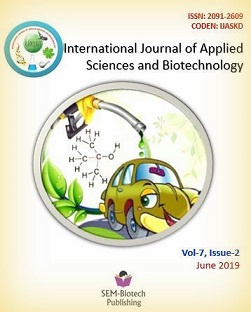Intraspecific plasticity in circadian rhythms within Euglena gracilis strain Z
Plasticity in circadian rhythms within Euglena
DOI:
https://doi.org/10.3126/ijasbt.v7i2.24278Keywords:
Euglena gracilis, Circadian rhythms, Intraspecific PlasticityAbstract
Natural plasticity in overt circadian rhythms can be observed in various animals. Little is known about how this phenomenon help Euglena gracilis adapt to environmental stimuli. We used four groups of strain Z. Two groups were from our laboratory, ZObihiro1 and ZObihiro2; Third group was from the National Institute for Environmental Studies, Japan (ZNIES-48) and the other was from Osaka Prefecture University (ZOsaka). The latter two were grown photoautotrophically at a light intensity of 84 μmol m-2 s-1 (day-white type lamps) at 25°C with air bubbling, as were ours, for two months prior to experiments. Results showed that ZObihiro2 and ZOsaka grew faster than ZObihiro1 and ZNIES-48. Upon transferring from light to darkness, population growth ceased within 8-10 h with the cell number increase in the dark of 41% in ZObihiro1 and ZObihiro2, 35% in ZOsaka and remarkably low 22% in ZNIES-48. Timing of cell division bursts in the circadian rhythm of cell population growth in 24 h light-dark cycles was the same in all four groups. Magnitudes of the rhythm were different: both ZObihiro1 and ZObihiro2 completely doubled, but ZNIES-48 multiplied by 1.9, and ZOsaka multiplied feebly by 1.7. The photoinduction of commitment to cell division in DD followed a circadian rhythm. All four showed the same peak at subjective dusk, but the amplitudes differed in the order, ZObihiro2 > ZOsaka > ZObihiro1 >> ZNIES-48. The resistance to photosensitization against Rose-Bengal follows a clear circadian rhythm in all substrains except in ZNIES-48. ZObihiro1 and ZOsaka showed the phasing similar to UV resistance rhythm, but ZObihiro2 did not. These results suggest the plasticity of circadian rhythms within a species, if not within a strain. Moreover, it is also apparent that different substrains/ecotypes present within the same Z strain.
Int. J. Appl. Sci. Biotechnol. Vol 7(2): 207-216




